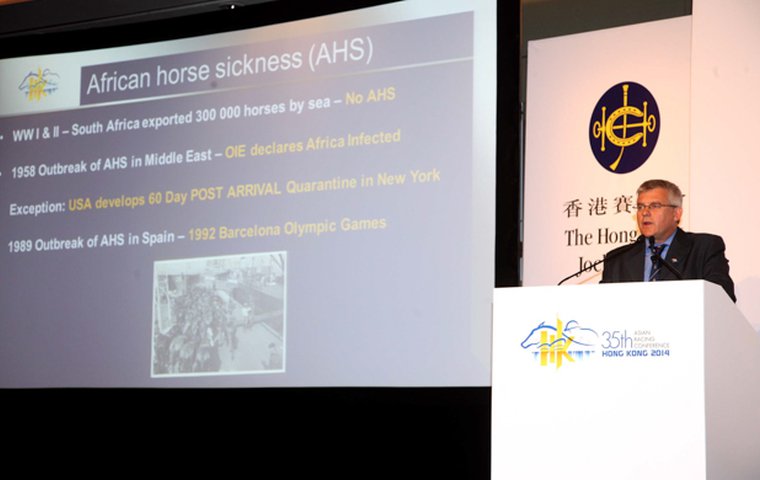
Recent developments seemed to promise hope that a possible relaxation of the extreme quarantine regulations affecting South Africa could be on the horizon. But, as Howard Wright found out at the Asian Racing Conference earlier this month, that may not be the case.
If the many vociferous supporters who greeted the stunning success of South Africa’s dual horse of the year, Variety Club, in the Champions Mile at Sha Tin Racecourse on the first Sunday in May thought a second successive victory on the international stage would open the door to less punishing quarantine regulations for their equine travelers, their hopes were shortlived.
Even Hong Kong Jockey Club CEO Winfried Engelbrecht-Bresges was moved to suggest that Variety Club’s world-class performance, following his win in the Godolphin Mile, could hardly have been more timely as a means of focusing further attention on the easier movement of racehorses.
“If there was no incentive before today, there is now,” Engelbrecht-Bresges told members of the media in his immediate Champions Mile response, pointing to imminent discussion of the subject at the Asian Racing Conference being hosted by his organisation on behalf of the Asian Racing Federation.
Yet just 48 hours later, a few miles southwest of the racecourse in the impressive setting of Hong Kong’s convention and exhibition centre, the key to the door was put to one side, if not exactly thrown away.
Some encouragement for South Africa had emerged the day before, when the International Federation of Horseracing Authorities (IFHA) executive council reaffirmed its support for efforts to reduce red tape in transporting Thoroughbreds to race. But Dr. Brian Stewart, head of equine welfare and veterinary services at Racing Victoria and chairman of the IFHA’s movement of horses committee, quickly set a more sombre tone while chairing the public session on the movement of horses.
“We have to be aware that these movements are controlled by national government authorities, and national veterinarians are inherently conservative and naturally risk aversive,” Stewart said. “To make change, we can’t just wish it to be so, or force it to be so.
“We need systems in place, and when we make depositions to government, we have to provide them with comfort that loosening movement controls is going to be safe, will protect the national horse population and is based on science, not on business priorities.”
In his IFHA role, Dr. Stewart is directly involved in the evolving collaboration with the World Organisation for Animal Health (OIE) and the International Equestrian Federation (FEI). Together, the three bodies are pursuing development of a streamlined policy for the movement of high-health, high-performance (HHP) horses, which has been outlined here and was reiterated in Hong Kong by Dr. Anthony Kettle, head of equine import and export for the Emirates Racing Authority and in charge of quarantine for the Dubai Racing Club.
The OIE’s position on and support for the HHP concept, which relies on a purebred passport being issued by recognised international organisations such as the FEI and national bodies, was outlined in public, for the first time that I am aware of, at the conference by Dr. Susanne Münstermann, from the OIE scientific and technical department in Paris.
Sparing no detail about the OIE’s history, standing, organisation, reach, and requirements, as befits a body whose website would take a week to digest, Dr. Münstermann nevertheless put African Horse Sickness, South Africa’s Achilles’ heel, in the spotlight almost from the outset, explaining that countries have been requested to declare they are free from the disease since 2013.
South Africa cannot comply since outbreaks in 2013 and this year outside the all-important “free zone,” in which the Kenilworth quarantine station is located, have extended the two-year ban on direct export imposed in 2011. This explains why Peter Gibson, stout defender of the faith as CEO of Racing South Africa, started on the back foot as he followed Dr. Münstermann up to the podium.
Drawing on Variety Club’s example, Gibson pointed out that 17 years earlier, London News had become the first South African-trained winner in Hong Kong when his success in the Queen Elizabeth II Cup followed direct shipping after 30 days’ quarantine, whereas the country’s most recent G1 victory had involved being on the road and in the air for four times longer.
“How is it possible that South African exporters face greater constraints than they did 17 years ago?” Gibson asked, adding that his country has spent 50 percent of the intervening time under suspension.
By the end of the session, Gibson admitted he was probably farther away from providing an answer than when he posed the question.
“The HHP project being pursued by the OIE, IFHA, and FEI will do nothing for our position,” he said. “The OIE already demands zoning, disease-free zones and compartmentalisation in its animal health code, which lists 11 equine diseases including African Horse Sickness, but we won’t qualify.”
By the end of the conference, after helping man a Racing South Africa booth in the exhibition area, Gibson was a little more cheery, admitting that the industry he represents, and particularly its big-name owners and breeders, would have to get their own house in order by greatly improving quarantine and testing, possibly at the existing facility in Kenilworth.
“Talking to the Hong Kong Jockey Club, the general mood appears to be more positive,” he said, “and there may be opportunities to review import conditions. Hong Kong would enable us to have an alternative market for good quality bloodstock at reasonable prices. After all, trade delivers technical solutions in an enabling environment.”
Gibson had better be careful that the ultra-cautious Dr. Brian Stewart does not get wind of any idea that may be construed as attempting to “loosen movement controls based on business priorities.”


